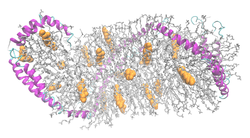- Apolipoprotein A1
-
Apolipoprotein A1 Zwei ApoA1-Moleküle (lila Bänder) im Komplex mit Cholesterin (orange Kalotten) und Phospholipiden, nach PDB 3K2S Vorhandene Strukturdaten: 1av1, 1gw3, 1gw4 Masse/Länge Primärstruktur 243 Aminosäuren Bezeichner Gen-Name APOA1 Externe IDs OMIM: 107680 UniProt: P02647 MGI: 88049 Vorkommen Übergeordnetes Taxon Wirbeltiere[1] Apolipoprotein A1 (ApoA1) ist das Protein im Blut von Wirbeltieren, das HDL-Partikel aus Cholesterin und Fettsäuren zusammenhält. Diese Partikel werden zur Leber transportiert und das Cholesterin dort abgebaut oder ausgeschieden (reverser Cholesterintransport). ApoA1 ist auch unentbehrlicher Kofaktor für das Enzym LCAT, das zu demselben Stoffwechselweg beiträgt. Es ist zudem Teil von Chylomikronen. Beim Mensch wird APOA1 in der Leber und im Dünndarm exprimiert. Mutationen in APOA1 können zu erblichem ApoA1-Mangel, und dieser zu HDL-Mangel oder Polyneuropathie Typ FAP-III führen.[2]
ApoA1 gehört zu den Apolipoproteinen, einer Gruppe von Transportproteinen.
Als Teil des SPAP-Komplexes aktiviert ApoA1 die Motilität der Spermien. Es interagiert mit ApoA1-bindendem Protein und Clusterin. In Alzheimer-Patienten bindet ApoA1 an Beta-Amyloid und verhindert Schäden durch dieses Protein. Infusionen mit ApoA1 werden in klinischen Studien[3] als mögliches Mittel gegen Atherosklerose in Erwägung gezogen. Atherosklerotische Patienten zeigen erhöhte Werte für ApoA1-Nitrat.[4][5][6]
Einzelnachweise
- ↑ Homologe bei OMA
- ↑ UniProt P02647
- ↑ Mendez AJ.: The promise of apolipoprotein A-I mimetics. In: Curr Opin Endocrinol Diabetes Obes.. 17, Nr. 2, April 2010, S. 171-6. PMID 20125002.
- ↑ Paula-Lima AC, Tricerri MA, Brito-Moreira J, et al.: Human apolipoprotein A-I binds amyloid-beta and prevents Abeta-induced neurotoxicity. In: Int. J. Biochem. Cell Biol.. 41, Nr. 6, Juni 2009, S. 1361–1370. doi:10.1016/j.biocel.2008.12.003. PMID 19130896.
- ↑ Feng Y, Van Craeyveld E, Jacobs F, Lievens J, Snoeys J, De Geest B: Wild-type apo A-I and apo A-I(Milano) gene transfer reduce native and transplant arteriosclerosis to a similar extent. In: J. Mol. Med.. 87, Nr. 3, März 2009, S. 287–97. doi:10.1007/s00109-008-0427-y. PMID 19066833.
- ↑ Bakillah A: Nitrated apolipoprotein A-I, a potential new cardiovascular marker, is markedly increased in low high-density lipoprotein cholesterol subjects. In: Clin. Chem. Lab. Med.. 47, Nr. 1, 2009, S. 60–9. doi:10.1515/CCLM.2009.017. PMID 19055467.
Weblinks
- D'Eustachio/Jassal/reactome: Conversion of pro-apoA-I to apoA-I
- D'Eustachio/Jassal/reactome: Apolipoprotein A-I binds membrane-associated cholesterol and phospholipid to form a discoidal HDL particle
Wikimedia Foundation.

